Matplotlib(基礎編)
Contents
Matplotlib(基礎編)#
まずは、Chainerチュートリアル通りプロット。 簡単なグラフはこれで十分です。
ここでは、numpyでデータを作成しつつプロットを行います。
import numpy as np
import matplotlib.pyplot as plt
numpyの使い方#
一定区間に等間隔で散らばった点を生成
np.arange(開始, 終了, 間隔)
x = np.arange(-1, 1, 0.1) # -1から1まで、0.1刻みで点を生成する
x
array([-1.00000000e+00, -9.00000000e-01, -8.00000000e-01, -7.00000000e-01,
-6.00000000e-01, -5.00000000e-01, -4.00000000e-01, -3.00000000e-01,
-2.00000000e-01, -1.00000000e-01, -2.22044605e-16, 1.00000000e-01,
2.00000000e-01, 3.00000000e-01, 4.00000000e-01, 5.00000000e-01,
6.00000000e-01, 7.00000000e-01, 8.00000000e-01, 9.00000000e-01])
関数にわたす
np.arrayを関数に渡すと、その要素全てに同じ操作が加えられます。
例)
np.array([1, 2, 3]) ** 2
# array([1, 4, 9])
その他、numpyで定義されている関数
sincostanlogexp
も使えます。
y = np.sin(x) # 生成した点をsin関数に渡す
y
array([-8.41470985e-01, -7.83326910e-01, -7.17356091e-01, -6.44217687e-01,
-5.64642473e-01, -4.79425539e-01, -3.89418342e-01, -2.95520207e-01,
-1.98669331e-01, -9.98334166e-02, -2.22044605e-16, 9.98334166e-02,
1.98669331e-01, 2.95520207e-01, 3.89418342e-01, 4.79425539e-01,
5.64642473e-01, 6.44217687e-01, 7.17356091e-01, 7.83326910e-01])
散布図#
plt.scatter(xの配列, yの配列)
平面状に点を打ちます。
x = np.arange(-1, 1, 0.1)
y = x ** 2
plt.scatter(x, y)
<matplotlib.collections.PathCollection at 0x10832fe50>
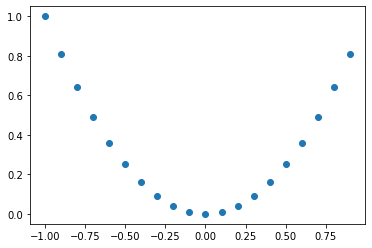
折れ線グラフ#
plt.plot(xの配列, yの配列)
散布図と異なり、隣り合った点をつなげます。
x = np.arange(-3, 3, 0.5)
y = np.sin(x)
plt.plot(x, y)
[<matplotlib.lines.Line2D at 0x108472b00>]
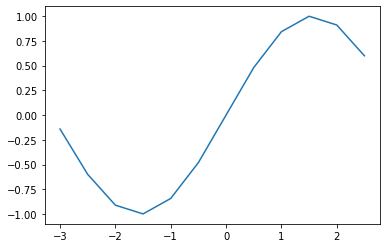
ヒストグラム#
データの生成
\(1〜6\) までの数字をランダムに \(1000\) 回選んで平均を求めます。
これを \(1000\) 回繰り返して、どんな分布になっているかをみてみます。
from random import randint
data = []
for i in range(1000):
# 1~6までの数字をランダムに選んで足す x 1000回
sum_of_dice = 0
for j in range(1000):
sum_of_dice += randint(1, 6)
ave_of_dice = sum_of_dice / 1000 # 1000で割って平均を出す
data.append(ave_of_dice)
print(data[:10]) # 10個目までを見る
[3.517, 3.437, 3.424, 3.409, 3.569, 3.421, 3.517, 3.541, 3.386, 3.412]
ヒストグラムを作成
plt.hist(データ)
自動的に階級の幅を決めてプロットしてくれます。 この場合は \(10\) 個の階級に分けられていました。
plt.hist(data)
(array([ 5., 16., 55., 124., 215., 262., 178., 101., 32., 12.]),
array([3.318 , 3.3524, 3.3868, 3.4212, 3.4556, 3.49 , 3.5244, 3.5588,
3.5932, 3.6276, 3.662 ]),
<BarContainer object of 10 artists>)
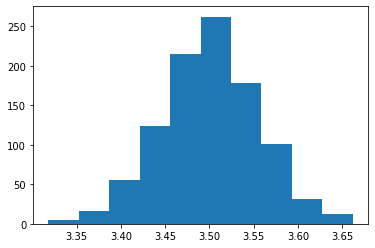
パラメータの調整#
hist関数にオプションで bins=100 を渡すと、階級を \(100\) 個に分けることができます。
plt.hist(data, bins=100)
(array([ 1., 0., 0., 0., 0., 1., 1., 0., 1., 1., 2., 0., 0.,
2., 0., 2., 0., 4., 2., 4., 4., 2., 3., 3., 9., 8.,
5., 10., 1., 10., 4., 9., 7., 14., 10., 10., 16., 11., 27.,
16., 20., 22., 19., 28., 14., 27., 14., 29., 22., 20., 35., 22.,
25., 19., 32., 26., 24., 33., 17., 29., 15., 24., 16., 18., 15.,
18., 15., 20., 20., 17., 20., 12., 12., 9., 9., 9., 10., 7.,
6., 7., 4., 6., 2., 5., 1., 5., 2., 1., 3., 3., 1.,
3., 2., 1., 0., 1., 1., 0., 2., 1.]),
array([3.318 , 3.32144, 3.32488, 3.32832, 3.33176, 3.3352 , 3.33864,
3.34208, 3.34552, 3.34896, 3.3524 , 3.35584, 3.35928, 3.36272,
3.36616, 3.3696 , 3.37304, 3.37648, 3.37992, 3.38336, 3.3868 ,
3.39024, 3.39368, 3.39712, 3.40056, 3.404 , 3.40744, 3.41088,
3.41432, 3.41776, 3.4212 , 3.42464, 3.42808, 3.43152, 3.43496,
3.4384 , 3.44184, 3.44528, 3.44872, 3.45216, 3.4556 , 3.45904,
3.46248, 3.46592, 3.46936, 3.4728 , 3.47624, 3.47968, 3.48312,
3.48656, 3.49 , 3.49344, 3.49688, 3.50032, 3.50376, 3.5072 ,
3.51064, 3.51408, 3.51752, 3.52096, 3.5244 , 3.52784, 3.53128,
3.53472, 3.53816, 3.5416 , 3.54504, 3.54848, 3.55192, 3.55536,
3.5588 , 3.56224, 3.56568, 3.56912, 3.57256, 3.576 , 3.57944,
3.58288, 3.58632, 3.58976, 3.5932 , 3.59664, 3.60008, 3.60352,
3.60696, 3.6104 , 3.61384, 3.61728, 3.62072, 3.62416, 3.6276 ,
3.63104, 3.63448, 3.63792, 3.64136, 3.6448 , 3.64824, 3.65168,
3.65512, 3.65856, 3.662 ]),
<BarContainer object of 100 artists>)
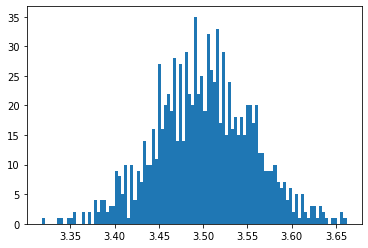
箱ひげ図#
データの生成
確率90%、60%、30%で表が出るコインを用意して、何回連続で表が出るかを調べます。
それぞれ1000回ずつ試行します。
from random import randint
prob_90 = []
prob_60 = []
prob_30 = []
for i in range(1000):
# 90%が何回連続で出るか
count_90 = 0
while randint(1, 100) <= 90:
count_90 += 1
prob_90.append(count_90)
# 60%が何回連続で出るか
count_60 = 0
while randint(1, 100) <= 60:
count_60 += 1
prob_60.append(count_60)
# 30%が何回連続で出るか
count_30 = 0
while randint(1, 100) <= 30:
count_30 += 1
prob_30.append(count_30)
print("90%: ", prob_90[:20])
print("60%: ", prob_60[:20])
print("30%: ", prob_30[:20])
90%: [5, 9, 17, 3, 11, 1, 12, 1, 7, 17, 10, 5, 0, 7, 7, 0, 24, 10, 1, 1]
60%: [3, 0, 0, 0, 1, 2, 8, 0, 4, 1, 2, 2, 1, 1, 1, 0, 0, 4, 2, 0]
30%: [0, 0, 0, 0, 1, 0, 0, 1, 0, 0, 1, 1, 0, 0, 0, 1, 0, 0, 0, 1]
plt.boxplot((prob_90, prob_60, prob_30))
{'whiskers': [<matplotlib.lines.Line2D at 0x10a39fa90>,
<matplotlib.lines.Line2D at 0x10a39fd60>,
<matplotlib.lines.Line2D at 0x10a3c0eb0>,
<matplotlib.lines.Line2D at 0x10a3c1180>,
<matplotlib.lines.Line2D at 0x10a3c2260>,
<matplotlib.lines.Line2D at 0x10a3c2530>],
'caps': [<matplotlib.lines.Line2D at 0x10a3c00a0>,
<matplotlib.lines.Line2D at 0x10a3c0370>,
<matplotlib.lines.Line2D at 0x10a3c1450>,
<matplotlib.lines.Line2D at 0x10a3c1720>,
<matplotlib.lines.Line2D at 0x10a3c2800>,
<matplotlib.lines.Line2D at 0x10a3c2ad0>],
'boxes': [<matplotlib.lines.Line2D at 0x10a39f760>,
<matplotlib.lines.Line2D at 0x10a3c0be0>,
<matplotlib.lines.Line2D at 0x10a3c1f90>],
'medians': [<matplotlib.lines.Line2D at 0x10a3c0640>,
<matplotlib.lines.Line2D at 0x10a3c19f0>,
<matplotlib.lines.Line2D at 0x10a3c2da0>],
'fliers': [<matplotlib.lines.Line2D at 0x10a3c0910>,
<matplotlib.lines.Line2D at 0x10a3c1cc0>,
<matplotlib.lines.Line2D at 0x10a3c3070>],
'means': []}
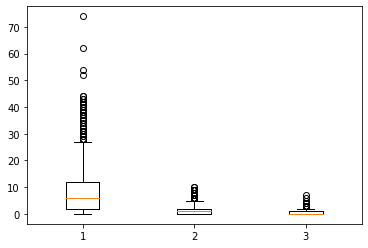
90%だと70回以上出ることもあるのに対して、 30%だと10回以上連続で出ることはほとんどないですね。
